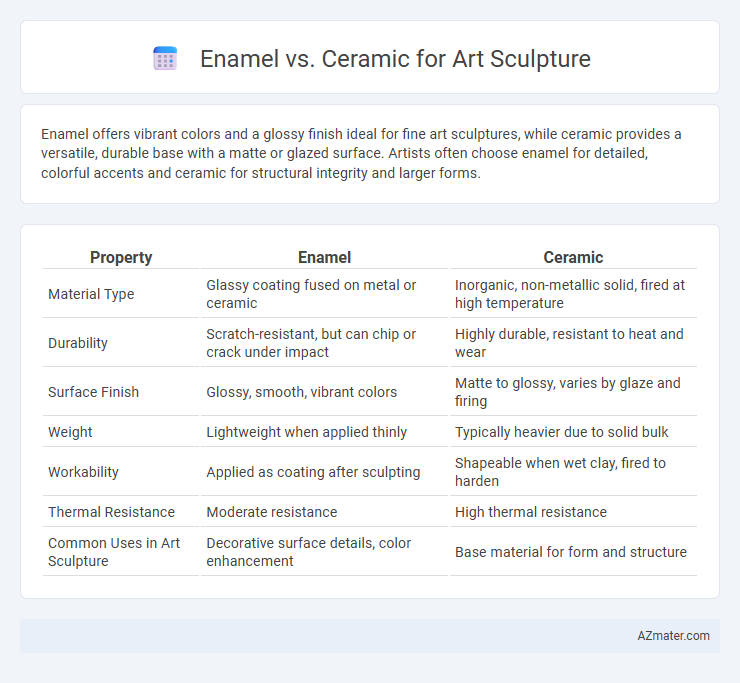Enamel offers vibrant colors and a glossy finish ideal for fine art sculptures, while ceramic provides a versatile, durable base with a matte or glazed surface. Artists often choose enamel for detailed, colorful accents and ceramic for structural integrity and larger forms.
Table of Comparison
| Property | Enamel | Ceramic |
|---|---|---|
| Material Type | Glassy coating fused on metal or ceramic | Inorganic, non-metallic solid, fired at high temperature |
| Durability | Scratch-resistant, but can chip or crack under impact | Highly durable, resistant to heat and wear |
| Surface Finish | Glossy, smooth, vibrant colors | Matte to glossy, varies by glaze and firing |
| Weight | Lightweight when applied thinly | Typically heavier due to solid bulk |
| Workability | Applied as coating after sculpting | Shapeable when wet clay, fired to harden |
| Thermal Resistance | Moderate resistance | High thermal resistance |
| Common Uses in Art Sculpture | Decorative surface details, color enhancement | Base material for form and structure |
Understanding Enamel and Ceramic Materials
Enamel in art sculpture involves fusing powdered glass onto a metal substrate at high temperatures, creating a smooth, glossy, and durable surface often used for intricate detailing and vibrant color effects. Ceramic materials in sculpture consist of fired clay or earthenware, prized for their versatility, range of textures, and ability to achieve both matte and glossy finishes through various glazing techniques. Understanding the differing thermal properties, durability, and aesthetic potentials of enamel and ceramic is crucial for artists to select the ideal medium based on the desired visual impact and structural requirements of their work.
Historical Uses in Art Sculpture
Enamel has been historically prized in art sculpture for its vibrant colors and durability, dating back to ancient civilizations such as the Egyptians and Byzantines, who used cloisonne and champleve techniques to decorate metal surfaces. Ceramic, with its origins in early human history, offered sculptors versatility and was central in cultures like the Greeks and Chinese, who crafted both functional and decorative pieces through kiln-fired clay. The enduring appeal of enamel and ceramic in art sculpture lies in their distinct aesthetic properties and ability to preserve intricate details over centuries.
Key Differences Between Enamel and Ceramic
Enamel is a glass-like coating fused onto metal surfaces at high temperatures, offering vibrant colors and a glossy finish, while ceramic refers to clay-based materials shaped and hardened by firing in a kiln, often resulting in a matte or textured surface. Enamel provides superior durability and resistance to scratches and chemical exposure compared to ceramic, which is more porous and fragile but allows for intricate sculptural detailing and varied glazing effects. The choice between enamel and ceramic for art sculpture depends on desired aesthetics, durability requirements, and the artist's technique preference.
Durability and Longevity Comparison
Enamel offers a highly durable finish resistant to chipping and fading, making it suitable for outdoor and high-traffic art sculptures. Ceramic, while aesthetically versatile and capable of fine detail, tends to be more fragile and prone to cracking or breaking under impact or extreme temperature changes. For long-term preservation in art sculpture, enamel coatings typically provide superior longevity due to their chemical stability and weather resistance.
Visual Aesthetics and Surface Qualities
Enamel offers vibrant, glossy finishes with rich color saturation and smooth, glass-like surfaces ideal for capturing intricate details in art sculptures. Ceramic provides a more matte or satin finish with textured, tactile surfaces that emphasize natural, earthy aesthetics and sculptural form. Both materials enhance visual appeal differently; enamel excels in brightness and shine, while ceramic highlights depth and texture through its varied glazing and firing techniques.
Techniques for Shaping and Finishing
Enamel for art sculpture involves fusing powdered glass to a metal substrate through high-temperature firing, allowing for intricate color layering and smooth, glossy finishes with durable surfaces. Ceramic techniques emphasize hand-building, wheel-throwing, or slip casting, followed by bisque firing, glazing, and a final high-temperature kiln firing that produces varied textures from matte to glossy. Both materials require precise control of temperature and timing in firing processes to achieve desired aesthetic effects and structural integrity in sculptural art.
Maintenance and Preservation Challenges
Enamel coatings on art sculptures offer vibrant colors and durability but require regular cleaning with mild, non-abrasive agents to prevent surface dulling and chipping. Ceramic sculptures demand careful handling to avoid cracks and chips, and their porous nature necessitates sealed surfaces to protect against moisture and staining. Preservation challenges for both materials include environmental factors like temperature fluctuations and humidity, which can cause expansion and contraction, leading to potential damage over time.
Cost Considerations for Artists
Enamel offers a cost-effective option for artists due to its lower material and firing expenses compared to ceramic, making it ideal for budget-conscious projects. Ceramic requires specialized kilns and higher-temperature firings, increasing overall production costs but providing durability and texture that justify the investment. Artists must weigh initial material costs against long-term value and artistic goals when choosing between enamel and ceramic for sculptures.
Suitability for Indoor vs Outdoor Sculptures
Enamel offers superior durability and resistance to weathering, making it highly suitable for outdoor sculptures exposed to varying environmental conditions. Ceramic, while prized for its fine detail and aesthetic versatility, is more fragile and prone to damage from moisture and temperature fluctuations, limiting its use primarily to indoor art pieces. Choosing enamel for outdoor installations and ceramic for indoor sculptures ensures longevity and preservation of artistic integrity.
Choosing the Right Material for Your Artistic Vision
Enamel offers vibrant colors and a glossy finish ideal for detailed, durable surface decoration in art sculpture. Ceramic provides versatility with various textures and finishes, allowing for both smooth and rough artistic expressions. Selecting between enamel and ceramic depends on the desired aesthetic, durability, and the tactile experience required to align with your artistic vision.

Infographic: Enamel vs Ceramic for Art Sculpture
 azmater.com
azmater.com